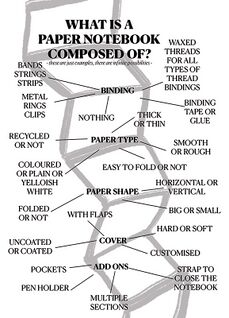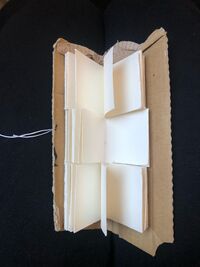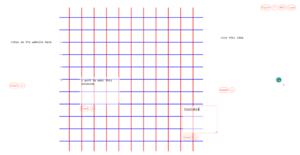User:FLEM/noteboox: Difference between revisions
| Line 129: | Line 129: | ||
i am making a prototype and using 4 rows: situation/need (A); binding (B); paper/space type/shape(C); add-ons (D). + one cardboard to hold everything. | i am making a prototype and using 4 rows: situation/need (A); binding (B); paper/space type/shape(C); add-ons (D). + one cardboard to hold everything. | ||
[[File:Threerowsnotebook.jpg|left|thumb|267x267px|a three rows notebook prototype]] | [[File:Threerowsnotebook.jpg|left|thumb|267x267px|a three rows notebook prototype]] | ||
'''<u>Interactive website</u>''' | '''<u>Interactive website</u>''' | ||
it starts like notebook kit with one rectangle in the middle and then the user can add pages of the same size in all directions (eg: having a website that only goes in one direction - if a user decides to) | * it starts like notebook kit (see [[User:FLEM/Notebook#20.09.22]]) with one rectangle in the middle and then the user can add pages of the same size in all directions (eg: having a website that only goes in one direction - if a user decides to) | ||
* you can move around only with the hand and not scrolling (is it called Drag to scroll? see https://htmldom.dev/drag-to-scroll/ or https://qodeinteractive.com/magazine/drag-interactions-in-web-design) | |||
* Then on the website there is also the random choice like in the printed notebook to play the game ''"how to make a notebook that"'' | |||
* Notification when you want to close the window of the website: you have to close it first! Every time you open all the pages when you close it you have to close all the pages before leaving (like with a real notebook!) why do we leave websites without closing them? Are they always open? | |||
[[File:Annotationforwebsites.png|left|thumb|300x300px|example of how the website could look like]] | [[File:Annotationforwebsites.png|left|thumb|300x300px|example of how the website could look like]] | ||
People can add notes and on the side you have an question mark and you click on and you see the notes of people on top of specific pages that have specific notes that can appear and disappear (see annotation tool from special issue 16 [https://hub.xpub.nl/soupboat/si16/annotation-compass/ at https://hub.xpub.nl/soupboat/si16/annotation-compass/] + see image) | People can add notes and on the side you have an question mark and you click on and you see the notes of people on top of specific pages that have specific notes that can appear and disappear (see annotation tool from special issue 16 [https://hub.xpub.nl/soupboat/si16/annotation-compass/ at https://hub.xpub.nl/soupboat/si16/annotation-compass/] + see image) | ||
'''<u>Reasons</u>''' | |||
As we create our personal spaces in the physical world, how can we perceive a similar feeling online? How can we expand and edit the spaces that already have intrinsic limits? Maybe creating limits inside the limits to give more freedom of choice in defining the limits of the space. | |||
<u>'''Questions''':</u> | |||
The notebook reconnects to the digital space in some way or not? Are they different experiments? why both? can the digital be a way to try to shift the same values to the internet? mmmmmm | |||
'''<u>Prepare for Clara:</u> TO DO ON THURSDAY AND FRIDAY MORNING''' | |||
''' | ''how to present my work properly? what's wrong with me? what can i do different/improve in my way of presenting the project?'' | ||
I don’t understand what I should say specifically in different situation | I don’t understand what I should say specifically in different situation | ||
Revision as of 13:49, 19 April 2023
Page where to leave all thoughts and ideas for the possible toolbox
maybe it's not gonna be a toolbox but it will be something
it's 19-04-23 and i am moving here to document the work towards graduation
general overview of the concept
Therefore, the final outcome will be a toolkit that will present, in different shapes, how to go through the analysis of self and the creation of personalised paper notebooks.
The Toolkit will be a box, probably, and will include a series of objects and materials:
- the thesis, printed on different papers, different sizes, every chapter, or paragraph will be different.
This version of the thesis will include a selection of photographs of the materials obtained in the last months, my notebooks, other people's notebooks, the CES, the experiments, the notes...
- different type of papers will be included, a cardboard to hold everything together, and other materials to help in the playground (metal rings, threads etc..)
- a "10 steps to make your own notebook", an instructional piece to go through different experiments.
it will include simple and accessible adds-on that users can use to start implementing their already-existing notebooks (like pockets, folding, additional papers..)
- a set of cards with questions to trigger the imagination
- a selection of short fictional stories based on the notebooks participants made during the sessions and influenced by the stories they told me.
These materials can be tried before the publications by participants or individuals that took part into my research.
ideas dump
to be elaborated
- "5 things to know about notebooks making"
- 10 steps to make your own notebook
- manifesto
- a "making a book" with the materials inside the "box"
- exercise/scheme of analysis of "personal notebook process"
- write a LEXICON as a way to explain things easily (what is your role into this practice?)
ideas development
exercise/scheme of analysis of "personal notebook process"
I need a series of questions that can describe it all in a few words.
| my personal notebook process | the ever-changing process a person can go through, by analysing and keeping attention to their individual note-taking activity and their use of paper notebooks to understand themselves and their needs. |
|---|---|
| What is the starting need that brought to the creation and use of it? | this question helps to highlight the starting point and main reason for the creation of a new notebook (or modification applied). it can be described in a few words. |
| What are the positive sides? Does it work within the starting purpose? | this is to understand if the solutions that have been found and applied to the new notebook are valid and working. this is important mostly not to lose track of the reasons underneath the concept and to evaluate how much the modifications worked. |
| What are the negative sides? What could be a different approach to solve the issue? | if what has been analysed above did not work, why didn't it work? analysing what worked and what did not help to reason on new ways to solve the issue that was not solved. |
| To try out: | a space to throw some ideas about practical solutions to apply to a possible new notebook or that can be applied directly to the version that is under monitoring. |
a second table for new ideas:
| new ideas for notebooks | |
|---|---|
| Need | being able to move the pages so that every space is a free space |
| Concept | write on separate sheets and then put them together with strings or rings |
| Pros | Different paper sheets so I can write separately and then decide how to organise the notes |
| Cons | It is annoying that I cannot add things to the text if the space is finished (absence of folded columns) |
Lexicon of practice
notebook
common book
The key word for the commonplace book is “annotated.” It is not just an anthology; the compiler reacts to the passages he has chosen or tells what the passages have led him to think about. A piece of prose, a poem, an aphorism can trigger the mind to consider a parallel, to dredge something from the memory, or perhaps to speculate with further range and depth on the same theme.
ephimera
scrapbook
scatchbook
diary
index cards
marginalia
book
user
maker
consumer
researcher
participant
accessible
notebook making
notes
19.04.23
tonight i could not sleep but produced ideas to work on
Card game for notebooks
Describe a situation, a need, a type of binding etc (take from the leaflet i made for last CES-see image) and mix and match to make little prototypes (e.g. how to make a notebook that is transportable but with a big space for writing with no binding?/concertina/rubberband)
Then to try out in CES after notebook discussion/analysis
How to make notebook making accessible? What does it mean accessible? Write in the lexicon
--> clara told me: why cards? are cards a notebook? rethink in as a notebook instead of a card game: what about the three rows notebook? Is it doable in bigger scale? can i make a series? see notebook idea User:FLEM/Notebook#30.09.22 & pic below
the options are printed on the different rows and attached with rings, and they can be turned around to mix and match the options like a random choice game -- > maybe write it more like a possible situation story: "I go in different locations to take notes so I need a notebook that is transportable (A); it does not have a binding (B); it needs a lot of space (C) for writing and sketching; it can have an additional feature if I find leaflets or information sheets around that I need to save (D) in this notebook" (all written in the different parts of the notebook, I need to be careful that everything can match in some way, but if it does not it could be interesting?)
i am making a prototype and using 4 rows: situation/need (A); binding (B); paper/space type/shape(C); add-ons (D). + one cardboard to hold everything.
Interactive website
- it starts like notebook kit (see User:FLEM/Notebook#20.09.22) with one rectangle in the middle and then the user can add pages of the same size in all directions (eg: having a website that only goes in one direction - if a user decides to)
- you can move around only with the hand and not scrolling (is it called Drag to scroll? see https://htmldom.dev/drag-to-scroll/ or https://qodeinteractive.com/magazine/drag-interactions-in-web-design)
- Then on the website there is also the random choice like in the printed notebook to play the game "how to make a notebook that"
- Notification when you want to close the window of the website: you have to close it first! Every time you open all the pages when you close it you have to close all the pages before leaving (like with a real notebook!) why do we leave websites without closing them? Are they always open?
People can add notes and on the side you have an question mark and you click on and you see the notes of people on top of specific pages that have specific notes that can appear and disappear (see annotation tool from special issue 16 at https://hub.xpub.nl/soupboat/si16/annotation-compass/ + see image)
Reasons
As we create our personal spaces in the physical world, how can we perceive a similar feeling online? How can we expand and edit the spaces that already have intrinsic limits? Maybe creating limits inside the limits to give more freedom of choice in defining the limits of the space.
Questions:
The notebook reconnects to the digital space in some way or not? Are they different experiments? why both? can the digital be a way to try to shift the same values to the internet? mmmmmm
Prepare for Clara: TO DO ON THURSDAY AND FRIDAY MORNING
how to present my work properly? what's wrong with me? what can i do different/improve in my way of presenting the project?
I don’t understand what I should say specifically in different situation
This is what I’d say to a teacher in this situation
This is how I would say it to a friend
This is how I would say it to someone who doesn’t know
This is what I would say if I have 3 minutes
(Gather materials and presentations and schemes on the presentation assessment etc)
What are the important things to make the project clear? Everyone gets stuck on different things; what do I do when I explain something I think it’s clear and then they ask me about it like I never said anything about it? (I probably said it wrong way?)



